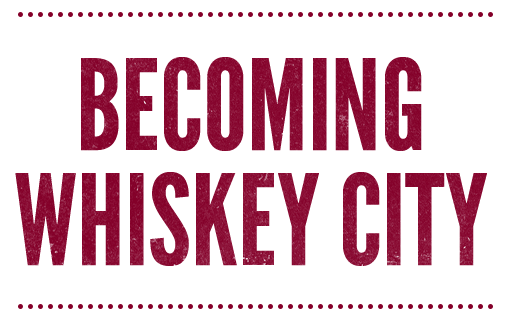COLONIAL AMERICA DISTILLS MOSTLY RUM, USING MOLASSES IMPORTED FROM THE WEST INDIES.
THE FIRST EVER AMERICAN WHISKEY ON RECORD IS DISTILLED BY SCOTCH-IRISH COLONISTS. IT’S AN UNAGED RYE WHISKEY.
BRITISH BLOCKADE PREVENTS AMERICANS FROM RECEIVING MOLASSES TO MAKE RUM. DISTILLERS IN PENNSYLVANIA AND MARYLAND START MAKING WHISKEY USING DOMESTICALLY GROWN RYE AND CORN.
THE FIRST COMMERCIAL DISTILLERY IS FOUNDED.
BECOMING WHISKEY CITY: THE HISTORY OF LAWRENCEBURG AND AMERICAN RYE
In 1802, just as whiskey consumption in America reached an all-time high, the small town of Lawrenceburg, IN appeared along the banks of the Ohio River. For decades, whiskey production had been thriving in Maryland, Pennsylvania, and, most recently, Kentucky. The next year, the Louisiana Purchase would expand trade into New Orleans, allowing distillers to ship barrels of whiskey to the West and South by steamboat.
Within the next century, Lawrenceburg would become known as Whiskey City—the rye-distilling capital of the world. Looking back, the events surrounding Lawrenceburg’s birth seem almost serendipitous. America was rife with opportunity for whiskey distillers, especially those with access to the mighty Ohio River.
A ONE-HORSE OPERATION
The first mash bills from Lawrenceburg in 1809 were produced in a grist mill powered by a single blind horse. This crude method of grinding grain meant the original Lawrenceburg distillery was limited to two barrels of whiskey per week. By contrast, George Washington’s distillery at Mount Vernon had already reached 11,000 gallons a year almost a decade earlier in 1797.
Still, Lawrenceburg was poised for opportunity. Being close to New Orleans trade routes meant that it was a prime location for distilling whiskey. With Kentucky focused on distilling bourbon, Lawrenceburg was primed to take over as the new leader in rye whiskey. With rich farmland on one side and the Ohio River on the other, it was only a matter of time before more Lawrenceburg distilleries began cropping up.
THE NEW AMERICAN GOVERNMENT IMPOSES A LIQUOR TAX (THE FIRST EVER DOMESTIC TAX) TO HELP PAY DEBTS FROM THE AMERICAN REVOLUTION. ALSO KNOWN AS THE “WHISKEY TAX.”
POLITICAL UNREST BETWEEN GRAIN FARMERS AND THE GOVERNMENT OVER THE WHISKEY TAX CULMINATES IN THE WHISKEY REBELLION. WASHINGTON SENDS 13,000 TROOPS TO DISBAND THE PROTESTS. IT WORKS.
GEORGE WASHINGTON OPENS A COMMERCIAL DISTILLERY AT MOUNT VERNON. IT GROWS TO BECOME ONE OF THE LARGEST DISTILLERIES IN AMERICA, PRODUCING 11,000 GALLONS OF WHISKEY PER YEAR.
THOMAS JEFFERSON TAKES OFFICE AFTER RUNNING ON A PLATFORM THAT PROMISED TO REPEAL THE WHISKEY TAX. WHISKEY CONSUMPTION SOARS.
THE TOWN OF LAWRENCEBURG, IN IS ESTABLISHED.
THE FIRST DISTILLERY OPENS IN LAWRENCEBURG, ITS GRIST MILL POWERED BY A SINGLE BLIND HORSE.
SOUR MASH IS DEVELOPED, REVOLUTIONIZING THE PRODUCTION OF WHISKEY, AND REMAINS A STANDARD TO THIS DAY.
THE TERM “BOURBON” IS OFFICIALLY USED TO DIFFERENTIATE WHISKEY MADE WITH CORN.
GEORGE ROSS ESTABLISHES WHAT WOULD BECOME ROSS & SQUIBB DISTILLERY IN LAWRENCEBURG, INDIANA.
ROSS & SQUIBB DISTILLERY: HISTORY IN THE MAKING
In 1847, amidst the golden age of rye, George Ross founded Lawrenceburg's most important distillery. Its name was Rossville Distillery, and for nearly two centuries, it has built a reputation for producing some of the world's finest rye whiskey. As one of Lawrenceburg's original distilleries, it holds the honor of being Indiana's oldest distillery still in operation.
Taking advantage of Lawrenceburg's natural gifts, Ross constructed his distillery atop an aquifer, providing the distillery with limestone-filtered water – the same high-quality water Ross & Squibb Distillery enjoys today. This prevented sulfur and iron compounds from negatively impacting the whiskey's taste, resulting in a bold, spicy flavor no other rye producer could replicate.
THE RISE AND FALL OF AMERICA’S SPIRIT
By 1913, America’s demand for rye was at an all-time high. Of the approximately 140 million gallons of liquor consumed that year, 135 million of them were whiskey. But in 1920, Prohibition brought American rye production to a grinding halt. A few distilleries were allowed to produce medicinal alcohol, resulting in over six million whiskey prescriptions for people who claimed to be “sick.”
After the repeal of Prohibition in 1933, the demand for rye and other American whiskeys declined as new generations discovered vodka, gin, and wine. Many whiskey distilleries closed their doors, but the original Ross & Squibb Distillery remained open, diversifying into other industries while still methodically working to perfect Lawrenceburg’s historic mash bills.
LAWRENCEBURG IS WELL ON ITS WAY TO BEING KNOWN AS WHISKEY CITY, WITH NEARLY 20 DISTILLERIES OPERATING IN DEARBORN COUNTY.
THE PURE FOOD & DRUG ACT FORCES THE LABELING OF “STRAIGHT” AND “BLENDED” WHISKEY. THIS IS A BLOW TO THE MARYLAND RYE STYLE, WHICH ADDED CHERRY OR PRUNE JUICE TO GIVE THE WHISKEY A SWEETER FLAVOR.
THE U.S. CONSUMES 135 MILLION GALLONS OF AMERICAN-MADE RYE AND BOURBON.
PROHIBITION BANS THE PRODUCTION AND SALE OF ALCOHOL WITH ONE EXCEPTION: MEDICINAL WHISKEY. LESS-BOLD CANADIAN WHISKEY IS SMUGGLED IN BY BOOTLEGGERS.
AMERICANS DISCOVER GIN, VODKA, AND WINE. WHISKEY SALES DECLINE.
MANY DISTILLERS RETURN TO THEIR ROOTS AND BEGIN TO EXPERIMENT WITH RYE AGAIN.
A CRAFT COCKTAIL REVIVAL BEGINS, CONTINUING TO THIS DAY.
RYE WHISKEY BECOMES ONE OF THE FASTEST-GROWING ALCOHOL CATEGORIES IN AMERICA.
A NEW GOLDEN AGE OF RYE
Rossville Union Master Crafted Straight Rye Whiskeys are a celebration of the historic Ross & Squibb Distillery and Lawrenceburg’s mastery of rye whiskey. With tremendous respect for America’s original spirit, we set out to create a rye that combines new American craftsmanship with the soul of 1847. The result is unmistakably bold and unapologetically spirited. The new golden age of rye has officially arrived.




